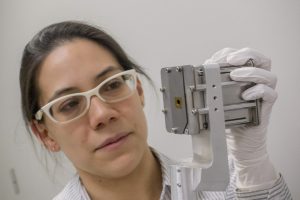Apr 25, 2018 | No Comments | By Michelle Pagano

Congratulations to June K. Wicks, a HEMI Fellow and an assistant professor in the Department of Earth and Planetary Sciences, who published a paper today in Science Advances reporting X-ray diffraction data on iron-silicon alloys at core conditions of “super-Earth” exoplanets.
Using high-powered laser beams, Wicks and her colleagues at Princeton University, Lawrence Livermore National Laboratory, and the University of Rochester have developed techniques to extend X-ray diffraction of solid materials to TPa pressures (1 TPa = 10 million atmospheres). This work represents the highest-pressure X-ray diffraction data ever reported.
With the continued discovery of thousands of planets outside our solar system, an effort that will be extended with instruments such as the James Webb Space Telescope, scientists are eager to learn more about interior structures of these exoplanets. However, in this quest researchers have encountered two major limitations: they have no direct measurements of our own planetary core from which to extrapolate, and interior pressures in super-Earths can reach more than 10 times the pressure at the center of the Earth, well beyond the range of conventional experimental techniques. By using groundbreaking techniques, Wicks and her colleagues have generated the first experimental data on likely constituent core materials at pressures exceeding 1.3 TPa, about three times higher than previous experiments. These data are directly useful for modeling the interior structure of large, rocky exoplanets, which in turn provides insights into the types of planetary architectures that may exist in our galaxy.
Wicks and her colleagues directed a short but intense laser beam onto two iron samples: one alloyed with 7 weight-percent silicon, similar to the modeled composition of Earth’s core, and another with 15 weight-percent silicon, relevant to more silicon-rich planets. They compressed these samples for only a few billionths of a second, but it was just long enough to probe the atomic structure using a pulse of bright X-rays. The resulting diffraction pattern provided information on the density and crystal structure of the iron-silicon alloys, revealing that the crystal structure changed with higher silicon content.
The researchers found that at ultrahigh pressures, the lower-silicon alloy organized into a hexagonal close-packed crystal structure, while the higher-silicon alloy adopted body-centered cubic packing.
“This atomic difference has enormous implications,” said Wicks. “Knowledge of the crystal structure is the most fundamental piece of information about the material making up the interior of a planet, as all other physical and chemical properties follow from the crystal structure.”
Future research will investigate how other light elements, such as carbon or sulfur, affect the structure and density of iron at ultrahigh pressure conditions. The researchers also hope to measure other key physical properties of iron alloys, to further constrain models of exoplanets’ interiors.
“Crystal structure and equation of state of Fe-Si alloys at super-Earth core conditions,” by June Wicks, Raymond Smith, Dayne Fratanduono, Federica Coppari, Richard Kraus, Matthew Newman, J. Ryan Rygg, Jon Eggert and Thomas Duffy was published April 25 in Science Advances. The research was funded by the National Nuclear Security Administration through the National Laser Users’ Facility Program (contract nos. DE-NA0002154 and DE-NA0002720) and the Laboratory Directed Research and Development Program at Lawrence Livermore National Laboratory (project no. 15-ERD-012).



